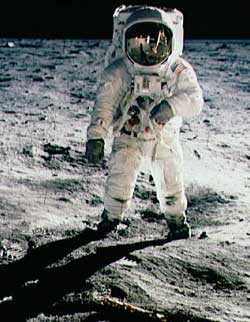2019 INTRODUCTION | PART 1 | PART 2 | PART 3 | PART 4 | PART 5 | PART 6 | LINKS
‘We choose to go to the moon’
BY MIKE WILLIAMS AND JADE BOYD
Rice News staff
When John F. Kennedy said “We choose to go to the moon” at Rice Stadium in 1962, he both changed the course of human history and cemented Rice’s place in the lore of America’s space program.

President John F. Kennedy delivers his famous Rice Stadium speech in
September 1962, describing his reasons for sending Americans to the moon.
Kennedy had established the goal of landing men on the moon more than a year earlier in a joint session of Congress, but it was the challenge he issued at Rice — to beat the Soviets to the moon before the end of the decade — that put the space race into overdrive.
Kennedy’s challenge was met 40 years ago, when Neil Armstrong and Buzz Aldrin stepped from their spacecraft onto the Sea of Tranquility. Apollo 11 came to symbolize America’s success in space, but the Apollo program’s deepest impact on mankind may well have been the generation of scientists it inspired and the laboratories and educational programs it paid to establish, including those that thrive at Rice today.
Within months of Kennedy’s speech, Rice became one of the nation’s first universities to establish a Department of Space Science. Within 18 months, satellites built at Rice were being launched aboard U.S. rockets. By the time Apollo 11 landed, several dozen graduate students and countless undergraduates had helped build instruments that made historic breakthroughs, instruments that remain on the lunar surface today.

Astronaut Buzz Aldrin poses for a famous photo on the lunar surface
taken by Neil Armstrong.
And the ties formed between NASA and Rice in the 1960s keep growing. For example, did you know that eight astronauts, including four who are still active, earned degrees at Rice? That two Rice faculty had joined the astronaut corps? That Rice researchers played a key role in building the Hubble Space Telescope? Or that Rice faculty were co-investigators on numerous robotic missions to other planets, including Voyagers 1 and 2, the Pioneer Venus Orbiter, the Mars Global Surveyor and the Cassini mission to Jupiter and Saturn?
Maybe you did.
But who knew the roots of Rice’s link to the space program go back more than 90 years, to a dorm room where two buddies dreamed about the future?



Leave a Reply